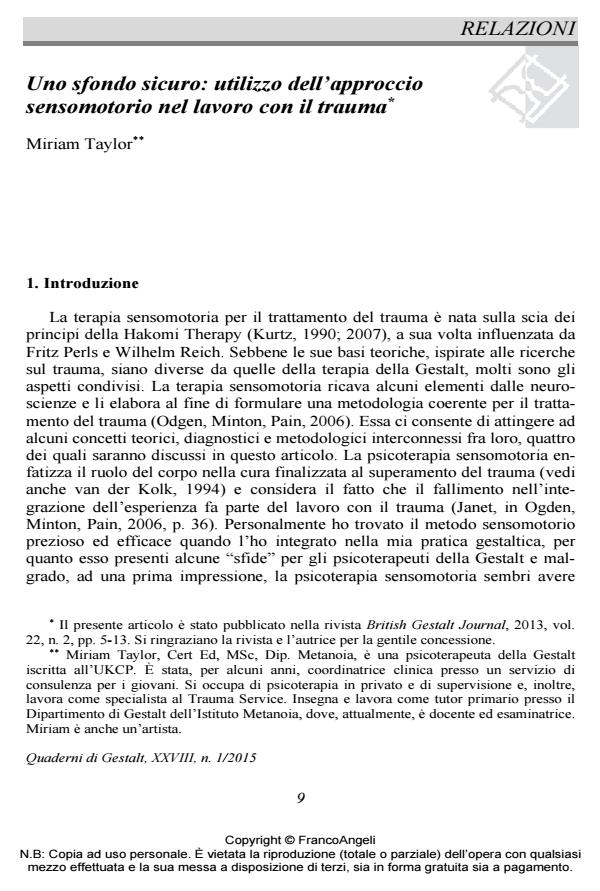On Safe Ground: Using Sensorimotor Methods in Trauma Work
Journal title QUADERNI DI GESTALT
Author/s Miriam Taylor
Publishing Year 2016 Issue 2015/1
Language Italian Pages 18 P. 9-26 File size 127 KB
DOI 10.3280/GEST2015-001002
DOI is like a bar code for intellectual property: to have more infomation
click here
Below, you can see the article first page
If you want to buy this article in PDF format, you can do it, following the instructions to buy download credits

FrancoAngeli is member of Publishers International Linking Association, Inc (PILA), a not-for-profit association which run the CrossRef service enabling links to and from online scholarly content.
Drawing on insights from neuro-science research, particularly in respect of autonomic arousal, brain structures and neural plasticity, this paper considers the impact of recent developments in the treatment of trauma, and ways to integrate new understandings with current Gestalt methodology. Sensorimotor Trauma Therapy offers some new concepts through which safe and effective trauma treatment can be re-considered. Through the use of clinical examples, the paper discusses the application of three Sensorimotor concepts integrating them with Gestalt practice. There is also a brief description of the role of defensive systems in trauma work from a Sensorimotor perspective. Relational aspects of this way of working are integrated into the text.
Keywords: Trauma, Sensorimotor, resources, window of tolerance, ANS arousal, defensive systems, figure formation, fixed Gestalts, creative adjustment
- Beisser A. (1970). The Paradoxical Theory of Change. Highland, NY: The Gestalt Journal Press.
- Boon S., Steele K., van der Hart O. (2011). Coping With Trauma – Related Dissociation. New York: Norton.
- Bromberg P. (2011). The Shadow of the Tsunami. New York: Routledge.
- Buchholz C. (2008). Complexity of Self-Reflection. Saarbrucken, KG: VDM Verlag Dr. Muller Aktiengesellschaft & Co.
- Emerson D. (2008). Yoga for Peace of Body and Mind – A Clinician’s Manual. Boston, MA: The Trauma Center.
- Fisher J. (1999). Stabilisation in Trauma Treatment. Unpublished paper, www.janinafisher. com/resources, accessed 3rd April 2012.
- Grigsby J., Osuch E. (2007). Neurodynamics, State, Agency and Psychological Functioning. In: Piers C., Muller J.P., Brent J., eds., Self-Organizing Complexity in Psychological Systems. Lanham, MD: Jason Aronson, 37-81.
- Kepner J. (1987; 1999). Body Process. Working with Body in Psychotherapy. Cambridge, MA: Gestalt Institute of Cleveland Press.
- Kepner J. (1995). Healing Tasks. San Francisco: Jossey-Bass Inc.
- Kepner J. (2003). The Embodied Field. British Gestalt Journal, 12, 1: 6-14.
- Kurtz R. (1990; 2007). Body-Centred Psychotherapy: The Hakomi Method. Mendocino, CA: Life Rhythm.
- Levine P. (1997). Waking the Tiger. Berkeley, CA: North Atlantic Books.
- Nijenhuis E., van der Hart O., Steele K. (2006). The Haunted Self. New York: Norton.
- Ogden P., Minton K., Pain C. (2006). Trauma and the Body. New York: Norton.
- Parnell L. (2007). A Therapist’s Guide to EMDR. New York: Norton.
- Philippson P. (2001). Self in Relation. Highland, New York: Gestalt Journal Press.
- Phillippson P. (2011). Mind and Matter: the Implications of Neuroscience Research for Gestalt Psychotherapy. In: Bar T., Levine Y., eds., Gestalt Therapy: Advances in Theory and Practice. Hove, UK: Routledge, 83-92.
- Polster E. (1995). A Population of Selves. San Francisco: Jossey-Bass.
- Ross C. (1997). Dissociative Identity Disorder. New York: Wiley and Sons.
- Rothschild B. (2002). The Body Remembers. New York: Norton.
- Siegel D.J. (1999). The Developing Mind. New York: Guilford Press.
- Stauffer K. (2010). Anatomy and Physiology for Psychotherapists. New York: Norton.
- van der Kolk B., McFarlane A., Weisaeth L., eds. (1996; 2007). Traumatic Stress. New York: Guilford Press.
- van der Hart O., Nijenhuis E.R.S., Steele K. (2006). The Haunted Self. New York: Norton.
Miriam Taylor, Uno sfondo sicuro: utilizzo dell’approccio sensomotorio nel lavoro con il trauma in "QUADERNI DI GESTALT" 1/2015, pp 9-26, DOI: 10.3280/GEST2015-001002